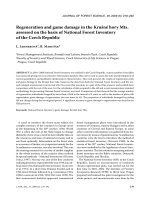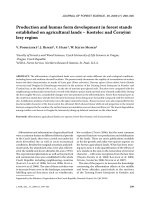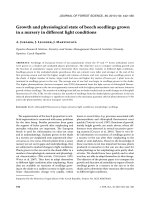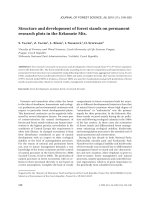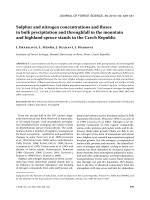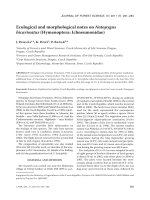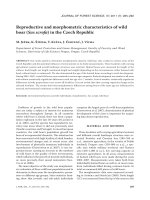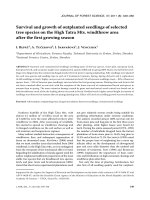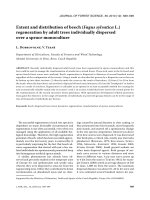Báo cáo lâm nghiệp: "Leaf and whole-plant water relations of the Patagonian conifer Austrocedrus chilensis (D. Don) Pic. Ser. et Bizzarri: implications on its drought resistance capacity" ppt
Bạn đang xem bản rút gọn của tài liệu. Xem và tải ngay bản đầy đủ của tài liệu tại đây (193.52 KB, 6 trang )
297
Ann. For. Sci. 62 (2005) 297–302
© INRA, EDP Sciences, 2005
DOI: 10.1051/forest:2005024
Original article
Leaf and whole-plant water relations of the Patagonian conifer
Austrocedrus chilensis (D. Don) Pic. Ser. et Bizzarri: implications
on its drought resistance capacity
Javier E. GYENGE*, María Elena FERNÁNDEZ, Guillermina DALLA SALDA, Tomás SCHLICHTER
INTA Estación Experimental Agropecuaria Bariloche, CC 277, 8400 San Carlos de Bariloche, Argentina
(Received 5 May 2004; accepted 18 October 2004)
Abstract – Physiological studies have suggested that A. chilensis would survive during drought avoiding water stress through an early stomatal
closure. However, there are no studies that have explored other potential mechanisms related to drought resistance or avoidance. The objectives
were: (1) to measure hydraulic resistance, vulnerability to cavitation and leaf water relations, and (2) to compare these characteristics between
different provenances. Pressure-volume curves demonstrate that A. chilensis has high osmotic potentials at full turgor, high water potentials at
turgor loss point, low modulus of elasticity, and did not present elastic or osmotic adjustments after drought. Compared to other gymnosperms,
A. chilensis has a high total plant resistance but also a high vulnerability to cavitation. We found no differences between the studied provenances
in these variables. Our results confirm that A. chilensis is a drought-avoidance species, and suggest that phenotypic morphological
differentiation between populations allows the species to survive throughout its broad distribution.
pressure-volume curves / xylem cavitation / stomatal conductance / drought avoidance / water stress
Résumé – Relations hydriques au niveau de la feuille et du plant chez un conifère de Patagonie Austrocedrus chilensis (D. Don) Pic. Ser.
et Bizzarri: implications pour sa capacité à résister à la sécheresse. Des études physiologiques suggèrent que l’Austrocedrus chilensis peut
survivre aux périodes de sécheresse évitant le stress hydrique grâce à une fermeture stomatique précoce. Cependant, il n’y a pas d’étude qui
eut exploré d’autres mécanismes potentiels liés à la résistance ou à l’évitement de la sécheresse. Les objectifs de ce travail ont été : (1) mesurer
la résistance hydraulique, la vulnérabilité à la cavitation et les relations hydriques des feuilles et (2) comparer ces caractéristiques avec celles
des populations de différentes provenances. Les courbes pression-volume ont démontré que l’Austrocedrus chilensis possède un potentiel
osmotique élevé à pleine turgescence, un potentiel hydrique au point de perte de turgescence, un module d’élasticité bas et qu’il ne présente pas
de réglage élastique ou osmotique après la sécheresse. En comparaison avec d’autres gymnospermes, l’Austrocedrus chilensis a une résistance
totale élevée mais aussi une importantee vulnérabilité à la cavitation. Nous n’avons pas trouvé de différences significatives entre les
provenances étudiées dans ces variables. Nos résultats confirment que l’Austrocedrus chilensis est une espèce qui évite la sécheresse, et ils
suggèrent que les changements phénotypiques entre populations permettent à cette espèce de survivre dans sa vaste distribution.
courbes pression-volume / cavitation du xylème / conductance stomatique / évitement de la sécheresse / tension hydrique
1. INTRODUCTION
South-American conifer Austrocedrus chilensis (D. Don)
Pic. Ser. et Bizzarri grows in northwestern Patagonia, Argen-
tina, in places with more than 2000 mm to less than 400 mm
of mean annual precipitation. All along its distribution, most
of the precipitation occurs during autumn and winter determi-
ning a drought period during summer. Austrocedrus chilensis
is considered one of the most drought tolerant tree species of
Patagonian region (e.g. [9]), and therefore, it is the most cons-
picuous species in Patagonian steppe. Across this region, sur-
vival of young trees is highly correlated to shrub presence sug-
gesting the phenomenon known as “nurse syndrome” [9]. This
syndrome is characterized by the amelioration of microenvi-
ronmental variables under a plant – the nurse – which enhances
survivorship and/or growth of other species growing in asso-
ciation with it. Measurements of stomatal behavior of A. chi-
lensis have shown a drought avoidance response, with an early
stomatal closure in response to vapor pressure deficit (VPD) or
to soil water stress [8]. It was suggested that this highly con-
servative use of water may be incompatible with efficient heat
dissipation by means of transpiration [8, 9], and that this may
explain the need of a nurse plant.
Despite of the wide geographic distribution of A. chilensis,
there are no large genetic differences among different prove-
nances, not even between those with very different phenotypes
* Corresponding author:
Article published by EDP Sciences and available at or />298 J.E. Gyenge et al.
nor between those exposed to opposite environments [16].
Accordingly, no differences were found in stomatal and pho-
tosynthetic response to drought between populations of A. chi-
lensis from humid and xeric places [8].
Mechanisms developed by trees to survive water deficits
include tolerance and avoidance of tissue water stress. Avoi-
dance of stress includes, for example, stomatal closure and
changes in leaf area and orientation, while stress tolerance
usually involves osmotic adjustment and also changes in elastic
properties of tissues (e.g. [19]). Drought avoider species may
be classified as “water spenders” or “water savers”, depending
on their water use [3, 15]. These authors enumerate the fol-
lowing physiological characteristics as typical of water saver
compared to water spender species: (1) lower osmotic poten-
tial; (2) more rigid cell walls (higher modulus elasticity);
(3) less vulnerability to xylem cavitation: and (4) stronger sto-
matal control over transpirational water loss. On the other hand,
plants species classified as water spenders have the opposite
characteristics.
Despite of ecological and economical value of A. chilensis
in Patagonian region, there are no studies that have explored
potential mechanisms related to drought resistance or avoi-
dance, except those related to stomatal behavior in saplings [8].
This information could be valuable for genetic improvement
programs (as those being carried out through subsidies of
National Government of Argentina), as well as to predict the
response of different populations to climatic change.
Based on this background, our goal was to understand the
physiological mechanisms that allow this species to survive
under drought conditions. In particular, the objectives of this
study were: (1) to measure hydraulic resistance of soil-to-leaf
water pathway, vulnerability to xylem cavitation and leaf water
relations obtained from pressure-volume curves in A. chilensis,
and (2) to compare these characteristics between different pro-
venances. Based on measured stomatal behavior [8], one of our
hypotheses was that A. chilensis possess characteristics of
water saver species. And based on genetic knowledge of the
species [16] we also hypothesized that these characteristics do
not differ between provenances.
In order to separate genetic from environmental influences
over studied variables, we measured saplings which seeds were
collected in populations representative of the environmental
extremes of the species distribution. They were bred in a green-
house in the EEA INTA Bariloche, Argentina. In addition, we
carried out some of these measurements in adult plants growing
in sites with climatic conditions similar to those of the saplings
origin.
2. MATERIALS AND METHODS
The study was carried out on plants of two different ages: three
years old saplings bred from seed, and adults. Saplings were produced
in the tree nursery of INTA Bariloche Experimental Station (National
Institute of Agricultural Technology, Argentina) from seeds collected
in several locations along the precipitation gradient. For our measure-
ments corresponding to Experiment 1 and 2 (see below), we chose
plants of two provenances situated in opposite sites of this gradient
(Pilcañeu – xeric site, and Catedral or Llao Llao – humid sites). Meas-
urements or, in other cases samples, of adult trees (Experiments 1, 2
and 3) were obtained in Catedral (humid site), Meliquina (mesic site)
and Alicura (xeric site). Geographical location and pluviometric char-
acteristics of each place are shown in Table I.
2.1. Experiment 1: Hydraulic resistance
2.1.1. Saplings
For each experiment we used five individuals of A. chilensis of each
provenance growing in a glasshouse in INTA Bariloche Experimental
Station. Following [21], at the steady state, the resistance from root to
leaf, R
plant
, and from root to stem, R
root+stem
, was calculated from:
R
plant
= – (ψleaf - ψsoil) / E
R
root+stem
= – (ψstem – ψsoil) / E
where ψ soil was water potential at soil-root interface and was esti-
mated from ψ leaf measured at pre-dawn in three plants. Water potential
of leaves (ψ leaf ) and ψstem were measured at midday in a transpiring
leaf and in a nontranspiring leaf (covered with aluminum foil 2 h
before the measurements, as was done by [21]), respectively. Water
potential measurements were carried out with a Scholander-type pres-
sure chamber (PMS Co, Corvallis, USA). Whole-plant transpiration
(E) was measured with a LICOR 6200 (Licor, Nebraska, USA) using
a one-liter chamber during 21 s, immediately before water potential
measurements. Due to the small size of plants, when we carried out
the measurements we made these considerations in order to avoid pos-
sible negative effect of branch cutting on transpiration rate.
We applied Kruskall-Wallis ANOVA (α = 0.05) to detect statistical
differences between provenances.
2.1.2. Adults
Hydraulic resistance was measured in adults of A. chilensis of the
mesic site (Tab. I), in four individuals in January 2001 (diameter at
breast height, DAP = 28.0, 30.6, 34 and 38.9 cm) and in three trees in
December 2001 (DAP = 15.3, 20.5, 25.4 cm).
Table I. Climatic characteristics of sites from which seeds or branches of Austrocedrus chilensis were collected (data extracted from [13]).
Site
Latitude
S
Longitude
W
Altitude
(m)
Precipitation
(mm year
–1
)
Pilcañeu Xeric 41° 13’ 70° 42’ 1100 330
Alicura Xeric 40° 39’ 71° 01’ 900 400
Meliquina Mesic 40° 03’ 71° 10’ 900 684
Catedral Humid 41° 08’ 71° 27’ 850 1350
Llao Llao Humid 41° 03’ 71° 32’ 800 1500
Water relations of A. chilensis in Patagonia 299
Whole-plant liquid phase hydraulic resistance (R
total
) was esti-
mated using the following formula:
R
total
= – (ψ leaf – ψ soil) / u
where ψ soil is soil water potential (estimated from predawn leaf water
potential), ψ leaf is leaf water potential at midday, and u was sapflow
density measured between 1100 and 1200 hours (see below). Resistance
of root to stem (R
root+stem
) was estimated only in December 2001 as:
R
root+stem
= – (ψ stem – ψ soil) / u
where ψ stem is leaf water potential measured in a branch covered with
a black plastic bag and sprayed with water, 3 h before ψ leaf meas-
urement.
Xylem sap flux density (u, mL cm
–2
min
–1
) was measured using
20 mm long continuously heated sap flow meters [5, 6]. Two pairs of
sensors were installed on the south side of the trunk of each tree and
covered with a radiation and rain shield to eliminate bias caused by
radiation heating. Measurements were carried out every 10 min and
stored in a datalogger (IMKO GMBH, Ettlingen, Germany) for further
processing. Sample unit was each tree (average of two pairs of sensors).
2.2. Experiment 2: Pressure-volume curves – saplings
and adults
Pressure-volume (P-V) curves were carried out during the growing
season 1999-2000 using a Scholander type pressure-chamber (PMS
Co, Corvallis, USA). P-V curves were conducted in little branches rehy-
drated to reach full turgor during a whole night. Parameters calculated
were: relative water content at turgor loss point (RWC
tlp
), water poten-
tial at turgor loss point (
ψ
l,tlp
), osmotic potential at full turgor (ψ
π
,sat
),
and bulk modulus of elasticity (
ε). Bulk modulus of elasticity was cal-
culated as in [23]:
ε = ∆P/∆R* (R*
x
– R*
a
), where R*
x
is mean relative
water content (R*) over the calculation interval,
∆R*, and ∆P is the
change in turgor over the same interval; R*
a
is the relative apoplastic
water content. R* was calculated as (W
f
– W
d
)/(W
t
– W
d
), where W
f
is the fresh weight, W
d
is the dry weight and W
t
is the turgid weight.
In adults, branches about 0.5 to 1 m long were collected from trees
growing in humid and xeric sites (four and six individuals, respec-
tively). Branches were placed in plastic bags to avoid desiccation dur-
ing transportation.
In saplings, P-V measurements were carried out in individuals from
xeric and humid provenances in two dates: March and April. In March,
we measured five well-watered saplings of each provenance. After
that, the ten plants were subjected to drought conditions (no irrigation
during a month) and they were re-measured in April. In the same day,
other three well-watered plants of each provenance were also meas-
ured in order to separate the effect of drought from phenology.
We compared results of different provenances (in saplings) or sites
(in adults) and irrigation treatments (in saplings). One-way ANOVA
was used to test the difference in all parameters among provenances/
sites within each age class (α = 0.05). ANOVA was also applied to
compare April measurements within each provenance (well-watered
vs. drought stressed saplings). Paired t tests were applied to compare
initial (before drought, March) and final (after drought, April) para-
meters within each provenance.
2.3. Experiment 3: Vulnerability curve – adults
Ten A. chilensis trees were sampled at humid, mesic and xeric sites.
The final portion of a single branch per tree (0.50 to 1 m long) was
harvested, wrapped in plastic black bags and brought to the laboratory.
Vulnerability to drought-induced xylem cavitation was measured
as the reduction in hydraulic conductivity of a stem as a function of
xylem pressure induced by air injection with a modified pressure
chamber. In general, we used the same procedure described by [13].
Segments (30 cm long) were excised from the branches, debarked, and
all lateral branches were cut to provide an entry point for air. All these
procedures were carried out under water. To determine maximum
hydraulic conductivity (k
max
) of each stem, before the induction of
cavitation the segment was cleared of existing air embolism using fil-
tered water at 170 kPa during one hour. Percent loss in conductivity
(PLC) following each chamber pressurization was calculated as PLC =
100 ((k
max
–k
h
)/ k
max
), were k
h
is hydraulic conductivity of the segment
measured after each chamber pressurization.
Vulnerability curves were fitted with an exponential sigmoid equa-
tion (following [13]):
PLC = 100 (1 + exp ( a (
ψ – b)))
where
ψ is the negative of injection pressure, a is a measure of the
degree to which conductivity responds to injection pressure (curve
shape) and b represents ψ at which a 50% loss in conductivity occurs
(curve displacement along the x-axis). Vulnerability curves for trees
from xeric and humid sites were carried out during December, while
those of trees from the mesic site were carried out in March.
In order to compare parameter values of vulnerability curves
between populations of A. chilensis, we applied T tests with
α = 0.05.
3. RESULTS
3.1. Experiment 1: Hydraulic resistance
No differences were found between saplings of different
provenances in total and partial resistances (P > 0.05, Tab. II).
R
roots+stem
:R
total
ratio was higher in adults (0.55) than in
saplings (0.23). Therefore, 45% of the total resistance occurs
at the leaf level in adult trees while in saplings R
leaf
represents
more than 70% of total resistance. Predawn water potential
(ψsoil) of adults was –0.48 (SD ± 0.03) MPa for 2000–2001
season and –0.47 (SD ± 0.15) MPa for 2001–2002 season.
Water potential at midday (ψleaf) was –1.24 (SD ± 0.13) MPa
and –1.18 (SD ± 0.06) MPa for 2000–2001 and 2001–2002
season, respectively.
3.2. Experiment 2: Pressure-volume curves
3.2.1. Saplings
Table III shows mean values of parameters estimated from
P-V curves. No differences between provenances were
Table II. Whole-plant hydraulic resistance (R
plant
) and resistance
across root and stem (R
root+stem
) of Austrocedrus chilensis. Values
are means ± SD.
R
plant
R
root+stem
Provenances/Site (MPa cm
2
s mmol
–1)
Xeric site Sapling 0.338 ± 0.257 0.08 ± 0.06
Humid site Sapling 0.308 ± 0.247 0.06 ± 0.04
Mesic site (Jan. 2001) Adult 1.4 ± 3.7 10
–4
–
Mesic site (Dec. 2001) Adult 1.7 ± 14 10
–4
9.1 ± 6.5 10
–5
300 J.E. Gyenge et al.
observed in any of the estimated parameters (P > 0.05). Con-
sidering well-watered plants, ψ
π,sat
was above –0.75 MPa in
March and above –1 MPa in April; ψ
l,tlp
was around –1.1 MPa
in March and close to –1.8 MPa in April; RWC
l,tlp
was always
around 0.80 and e was around 1 MPa in March and increased
above 2 MPa in April (Tab. III).
In the irrigation experiment, no osmotic adjustment was
observed after the desiccation period (ψ
π,sat
was similar between
dates, P > 0.05). In addition, ψ
l,tlp
and RWC
l,tlp
showed no
changes after the drought period (April) compared to initial val-
ues (March, P > 0.05, Tab. III). On the contrary, a significant
increase in ε was observed in the same plants between dates
(P < 0.05, Tab. III). However, similar values of ε were also
observed in well-watered plants measured in April, indicating
that this increment in ε was not due to irrigation treatment as
was also reported in other species [3, 23].
3.2.2. Adults
Significant differences were detected between adults from
both sites in ψ
π,sat
and ε (P < 0.05, Tab. III). A lower ψ
π,sat
and a higher ε were estimated in plants of the humid site com-
pared to those of the xeric place. No differences between sites
were detected in ψ
l,tlp
nor RWC
l,tlp
(P > 0.05, Tab. III).
3.3. Experiment 3: Vulnerability curve
We found significant differences (P < 0.05) in the shape of
vulnerability curve between trees from the mesic site compared
to plants of the other two sites (Tab. IV). However, pressure at
which a 50% loss in conductivity occurs estimated for the three
sites was the same (Fig. 1, P > 0.05), with a mean value of
–2.12 MPa (Tab. IV). Maximum conductivity of the stems
(k
max
± SD) was the same for trees from humid and xeric sites
(7.20 ± 0.66 and 7.79 ± 0.45 kg m
–1
MPa
–1
s
–1
, respectively)
and lower (P < 0.05) for the mesic site (4.34 ± 0.67 kg m
–1
MPa
–1
s
–1
). Differences between plants of the mesic site and
those of the other two sites could be related to differences in
sampling period [21] and/or genetic differences.
4. DISCUSSION
Accordingly to previous genetic [16] and physiological stu-
dies [8], we did not detect differences between provenances/
sites in leaf water relations, hydraulic resistance, nor vulnera-
bility to xylem cavitation. These results support partially our
initial hypothesis.
Table III. Mean (± SD) value of relative water content at turgor loss point (RWC
tlp
), water potential at turgor loss point (ψ
l,tlp
; MPa), osmotic
potential at full turgor (ψ
π,sat
; MPa) and bulk modulus of elasticity (ε, MPa) measured in Austrocedrus chilensis saplings and adults.
Sites Age RWC
tlp
ψ
l,tlp
ψ
,sat
e
Humid Sapling# 0.82 ± 0.06 –1.10 ± 0.22 –0.72 ± 0.21 1.16 ± 0.11
Humid Sapling** 0.80 ± 0.08 –1.91 ± 0.09 –1.25 ± 0.14 2.94 ± 0.10
Humid Sapling* 0.77 ± 0.05 –1.22 ± 0.24 –0.83 ± 0.15 2.93 ± 0.68
Humid Adults 0.82 ± 0.13 a –1.53 ± 0.32 a –1.05 ± 0.20 a 2.75 ± 0.82 a
Xeric Sapling# 0.76 ± 0.09 –1.10 ± 0.20 –0.55 ± 0.20 0.91 ± 0.34
Xeric Sapling** 0.81 ± 0.03 –1.70 ± 0.29 –1.03 ± 0.42 1.88 ± 0.69
Xeric Sapling* 0.76 ± 0.04 –1.10 ± 0.35 –0.68 ± 0.31 2.00 ± 0.70
Xeric Adult 0.86 ± 0.03 a –1.25 ± 0.32 a –0.68 ± 0.20 b 0.64 ± 0.19 b
# Initial condition of the individuals (well irrigated, measurements in March), * with and ** without drought period (measurements in April).
Arrows indicate significant differences between sapling groups (paired t test or ANOVA, P < 0.05). Different letters indicate statistical differences
between adult plants of different sites (ANOVA P <0.05).
Table IV. Mean (± SD) slopes (a) and intercepts (b) of equation, fit-
ted to vulnerability curves of Austrocedrus chilensis adults from dif-
ferent sites. Different letters indicate significant differences in each
parameter between sites (T tests, α = 0.05).
Site a b (MPa) R
2
adj. F-value
Humid 1.56 (± 0.20) a –2.07 (± 0.08) a 0.87 215.21
Mesic 0.83 (± 0.09) b –2.19 (± 0.11) a 0.88 197.023
Xeric 1.18 (± 0.13) a –2.13 (± 0.10) a 0.89 255.577
Combined
(pooled data)
1.14 (± 0.08) –2.12 (± 0.06) 0.86 593.279
Figure 1. Vulnerability curves of stems of Austrocedrus chilensis
trees growing in three sites contrasting in precipitation level (see
Tab. I). See Table IV for parameters of each regression model.
Water relations of A. chilensis in Patagonia 301
However, our results do not agree with previously proposed
physiological characteristics of water saver plants [3, 15]. In
spite of A. chilensis having a strong stomatal control, limiting
probably its establishment to nurse plants [8, 10], it did not present
the other characteristics of water saver plants. On the contrary,
A. chilensis showed typical values of water spender species [3]
in relation to osmotic potential, water potential and cell water
content at turgor loss point, hydraulic resistance and vulnera-
bility to xylem cavitation.
Low values of water potential at which cells of A. chilensis
loose turgor (around –1.3 MPa in adult plants) agree with mid-
day leaf water potentials measured under field conditions
(around –1.2 MPa). Preliminary stomatal conductance mea-
surements carried out under the same field conditions indicated
that A. chilensis closes its stomata early in the morning in order
to maintain high leaf water potentials [8]. Compared with other
species (e.g. [3, 23]), ε values of A. chilensis are very low, sug-
gesting high cell wall elasticity. As in water spender species,
this characteristic is correlated with a high ψ
π,sat
, both of which
would impede them to extract soil water efficiently and to
recover from leaf water deficit easily under low soil water avail-
ability [3]. In addition, we did not detect osmotic or elastic
adjustments after the drought experiment as was predicted for
drought avoidance species [19]. As a whole, results from P-V
curves suggest that A. chilensis has typical parameters of water
spender species. However, the strong stomatal control of tran-
spiration prevents such a behavior in relation to water use [8].
Hydraulic resistance (R
plant
) of A. chilensis saplings was
higher than R
plant
of the riparian species Acer saccharinum L.
(0.018 MPa cm
2
s mmol
–1
, [21]). Also, R
plant
of A. chilensis
saplings was higher than several provenances of P. halepensis
Mill. [16, 20]. However, the R
stem+root
:R
plant
ratio found in A.
chilensis were lower than those found in that species (approx-
imately 80%, respectively, [21]). Total resistance measured in
A. chilensis adults was higher than that measured in P. ponde-
rosa trees growing in the same place (1.2 10
–4
to 9.4 10
–5
MPa
cm
2
s mmol
–1
, Meliquina, Patagonia Argentina; [7]) or P. pon-
derosa growing in USA (6.1 10
–5
MPa cm
2
s mmol
–1
[11]).
Compared to several European Mediterranean tree species,
R
plant
of A. chilensis was also higher (2.9 10
–5
to 4 10
–4
MPa
cm
2
s mmol
–1
, [14]), as well to other six Pinacea species of
northern hemisphere [18]. In spite of this high resistance, vul-
nerability to cavitation of A. chilensis was higher than that
reported for P. ponderosa [13, 18] and other Mediterranean spe-
cies except Quercus ilex [14]. This last species was catalogued
as a drought avoider species [4], and shares with A. chilensis a
high stomatal control of transpiration and high vulnerability to
cavitation (but see Tyree and Cochard [22] who found contrast-
ing results about vulnerability to cavitation in that Quercus spe-
cies). Our results in saplings and adults indicate that the high
R
plant
is mainly located at the leaf level. Based on the classifi-
cation proposed by Cruiziat et al. [2], A. chilensis belongs to
the group of trees that control extension of embolism by sto-
matal closure. This was also observed in many species such as
P. sylvestris L. [17, 18], Q. petraea [1] and Picea abies (L.)
Karst. [12]. In this group of trees the value of ψ
xylem
which pro-
vokes 10% loss of hydraulic conductivity also lead to a 90%
of stomatal closure.
In conclusion, these and previous results [8] demonstrate
that the main physiological mechanism that allow A. chilensis
to survive water deficits is its strong stomatal control. This spe-
cies has no additional mechanisms, such as osmotic or elastic
adjustment, or a low vulnerability to xylem cavitation, at the
leaf or xylem levels, which can help it to tolerate drought peri-
ods. In contrast, its high ψ
l,tlp
, ψ
π,sat
and ψ at which looses 50%
of xylem conductivity, suggest that it is a species that evolved
without drought stress, but it is currently exposed to limiting
conditions. These results allow us to suppose that the main
mechanism of A. chilensis that permit its broad geographic dis-
tribution may be related with changes at morphological whole
plant level, such as in the ratio leaf area / sapwood area, as was
proposed for other species (e.g. [13]).
Acknowledgements: This research was partially funded by INTA
(National Institute for Agricultural Technology) and SECyT through
the project PICT 08-09415. M.E. Fernández was supported by a fel-
lowship for graduate students of CONICET. We also thank the support
of the Genetics Group of INTA EEA Bariloche, which provided the
plants for the experiments. We also thank two anonymous reviewers
for their valuable comments.
REFERENCES
[1] Cochard H., Bréda N., Granier A., Whole tree hydraulic conduc-
tance and water loss regulation of Quercus petraea during drought:
evidence for stomatal control of embolism? Ann. Sci. For. 53
(1996) 197–206.
[2] Cruiziat P., Cochard H., Améglio T., Hydraulic architecture of
trees: main concepts and results, Ann. For. Sci. 59 (2002) 723–752.
[3] Dong X., Zhang X., Some observations of the adaptations of sandy
shrubs to the arid environments in the Mu Us Sandland: leaf water
relations and anatomic features, J. Arid Environ. 48 (2001) 41–48.
[4] Fotelli M.N., Radoglou K.M., Constantinidou H I.A., Water stress
responses of seedlings of four Mediterranean oak species, Tree
Physiol. 20 (2000) 1065–1075.
[5] Granier A., Une nouvelle méthode pour la mesure du flux de sève
brute dans le tronc des arbres, Ann. Sci. For. 42 (1985) 193–200.
[6] Granier A., Evaluation of transpiration in a Douglas-fir stand by
means of sapflow measurements, Tree Physiol. 3 (1987) 309–320.
[7] Gyenge J.E., Fernández M.E., Schlichter T.M., Water relations of
ponderosa pines in Patagonia Argentina: implications for local
water resources and individual growth, Trees 17 (2003) 147–423.
[8] Gyenge J.E., Uso De Agua y resistencia a la sequía de Pino Ponde-
rosa y Ciprés de la Cordillera, Universidad Nacional Del Comahue,
Centro Regional Universitario Bariloche, Doctoral thesis (in revi-
sion by the Academic Committee).
[9] Kitzberger T., Fire regime variation along a northern Patagonian
forest-steppe gradient: stand and landscape responses, Ph.D. thesis,
Department of Geography, Univ. Colorado, Colorado, USA, 1995,
pp. 1–203.
[10] Kitzberger T., Steinaker D.F., Veblen T.T., Effects of climatic
variability on facilitation of tree establishment in Northern Patago-
nia, Ecology 81 (2000) 1914–1924.
[11] Kolb T.E., Stone J.E., Differences in leaf gas exchange and water
relations among species and tree sizes in an Arizona pine-oak
forest, Tree Physiol. 20 (2000) 1–2.
[12] Lu P., Biron P., Granier A., Cochard H., Water relations of adults
Norway spruce (Picea abies (L.) Karst.) under soil drought in the
Vosges mountains: whole tree hydraulic conductance, xylem embo-
lism and water loss regulation, Ann. Sci. For. 53 (1996) 113–121.
302 J.E. Gyenge et al.
[13] Maherali H., DeLucia E.H., Xylem conductivity and vulnerability
to cavitation of ponderosa pine growing in constrasting environ-
ments, Tree Physiol. 20 (2000) 859–867.
[14] Martínez-Vilalta J., Prat E., Oliveras I., Piñol J., Xylem hydraulic
properties of roots and stems of nine Mediterranean woody species,
Oecologia 133 (2002) 19–29.
[15] Monson R.K., Smith S.D., Season water potential components of
Sonoran desert plants, Ecology 63 (1982) 113–123.
[16] Pastorino M.J., Genetic variation and reproduction system of Aus-
trocedrus chilensis (D. Don) florin et Boutelje, a cypress endemic
to the Andean-Patagonian Forest, Ph.D. thesis, Cuvillier Verlag,
Göttingen, Germany, 2000, pp. 1–165.
[17] Perks M., Irvine J., Grace J., Xylem acoustic signals from mature
Pinus sylvestris during an extended drought, Ann. For. Sci. 61
(2004) 1–8.
[18] Piñol J., Sala A., Ecological implications of xylem cavitation for
several Pinaceae in the Pacific Northern USA, Funct. Ecol. 14
(2000) 538–545.
[19] Torrecillas A., Alarcón J.J., Domingo R., Planes J., Sánchez-
Blanco M.J., Strategies for drought resistance in leaves of two
almond cultivars, Plant Sci. 118 (1996) 135–143.
[20] Tognetti R., Michelozzi M., Giovannelli A., Geographical variation
in water relations, hydraulic architecture and terpene composition
of Aleppo pine seedlings from Italian provenances, Tree Physiol.
17 (1997) 241–250.
[21] Tsuda M., Tyree M.T., Whole-plant hydraulic resistance and vulne-
rability segmentation in Acer saccharinum, Tree Physiol. 17 (1997)
351–357.
[22] Tyree M.T., Cochard H., Summer and winter embolism in oak:
impact on water relations, Ann. Sci. For. 53 (1996) 173–180.
[23] White D.A., Beadle C.L., Worledge D., Leaf water relations of
Eucalyptus globulus ssp. globulus and E. nitens: seasonal, drought
and species effects, Tree Physiol. 16 (1996) 469–476.
To access this journal online:
www.edpsciences.org

